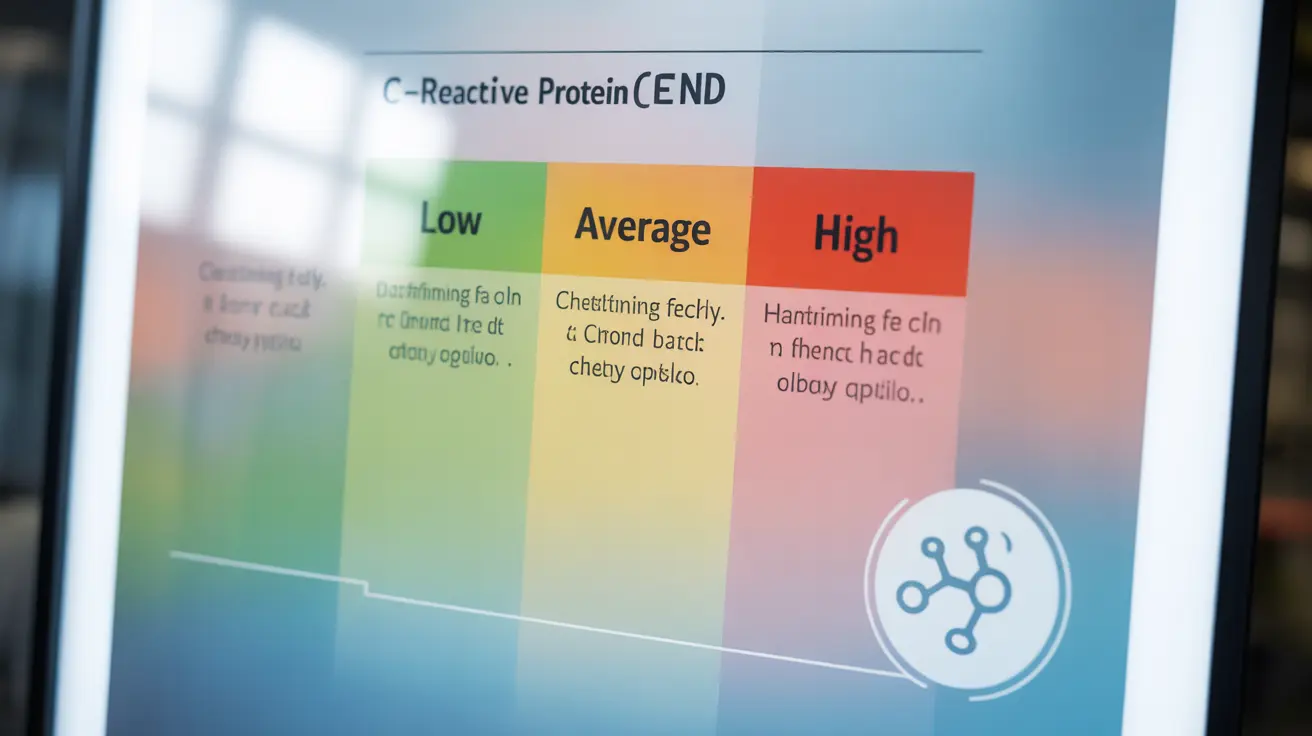C-reactive protein (CRP) is a crucial biomarker that healthcare providers use to assess inflammation in your body. When you receive blood test results showing elevated CRP levels, it's natural to wonder about the significance and potential health implications. Understanding what constitutes dangerous CRP levels can help you make informed decisions about your healthcare and know when to seek immediate medical attention.
CRP testing has become an essential tool in modern medicine, helping doctors diagnose various conditions, monitor treatment progress, and assess cardiovascular risk. This comprehensive guide will help you understand CRP level ranges, their clinical significance, and the steps you should take based on your test results.
Understanding CRP Levels and Normal Ranges
C-reactive protein is produced by your liver in response to inflammation anywhere in your body. Normal CRP levels are typically very low, usually less than 3.0 mg/L in healthy adults. However, the interpretation of CRP levels depends on the specific test performed and your individual health circumstances.
For general inflammation assessment, CRP levels are categorized as follows: levels below 1.0 mg/L are considered low risk, 1.0-3.0 mg/L indicate average risk, and levels above 3.0 mg/L suggest high risk for cardiovascular disease. When assessing acute inflammation or infection, different thresholds apply, with levels above 10 mg/L typically indicating significant inflammatory processes.
It's important to note that CRP levels can vary based on age, gender, and underlying health conditions. Women generally have slightly higher baseline CRP levels than men, and levels tend to increase with age. Certain medications, lifestyle factors, and chronic conditions can also influence your baseline CRP measurements.
Dangerous CRP Levels: When to Be Concerned
CRP levels become concerning when they reach certain thresholds that indicate serious underlying conditions. Moderately elevated levels between 10-100 mg/L may suggest bacterial infections, autoimmune disorders, or significant tissue damage. These levels warrant medical evaluation and often require additional testing to determine the underlying cause.
Severely elevated CRP levels above 100 mg/L are considered dangerous and typically indicate serious conditions such as severe bacterial infections, sepsis, major tissue necrosis, or acute inflammatory conditions. Levels exceeding 200-300 mg/L often signal life-threatening conditions that require immediate medical intervention and hospitalization.
However, it's crucial to understand that CRP levels should never be interpreted in isolation. Healthcare providers consider your symptoms, medical history, physical examination findings, and other laboratory tests when determining the clinical significance of elevated CRP levels. A single elevated reading doesn't automatically indicate a dangerous condition, but it does warrant further investigation.
Common Causes of Elevated CRP Levels
Numerous conditions can cause CRP levels to rise, ranging from minor inflammatory processes to serious medical emergencies. Acute infections, particularly bacterial infections like pneumonia, urinary tract infections, or skin infections, commonly cause significant CRP elevation. Viral infections typically cause more modest increases compared to bacterial infections.
Chronic inflammatory conditions such as rheumatoid arthritis, inflammatory bowel disease, and lupus can cause persistently elevated CRP levels. Cardiovascular conditions, including heart attacks and unstable angina, also trigger CRP elevation as part of the inflammatory response to cardiac tissue damage.
Other causes include tissue trauma from surgery or injury, certain cancers, autoimmune disorders, and chronic conditions like diabetes or obesity. Even lifestyle factors such as smoking, excessive alcohol consumption, lack of sleep, and chronic stress can contribute to elevated CRP levels over time.
CRP Testing in Rheumatoid Arthritis Management
In rheumatoid arthritis, CRP testing serves as a valuable tool for both diagnosis and ongoing management. Elevated CRP levels often correlate with disease activity, helping healthcare providers assess the effectiveness of treatment and make necessary adjustments to medication regimens.
During active rheumatoid arthritis flares, CRP levels typically rise significantly, often ranging from 20-100 mg/L or higher. As treatment progresses and inflammation decreases, CRP levels should correspondingly decline. This makes CRP an excellent biomarker for monitoring treatment response and disease progression.
Healthcare providers use CRP testing in combination with other inflammatory markers like erythrocyte sedimentation rate (ESR) and clinical assessments to develop comprehensive treatment plans. Regular CRP monitoring helps identify early signs of disease flares, allowing for prompt treatment adjustments before symptoms become severe.
Cardiovascular Risk Assessment and CRP
High-sensitivity CRP (hs-CRP) testing has revolutionized cardiovascular risk assessment, providing valuable information about heart disease risk even in apparently healthy individuals. This specialized test can detect very low levels of CRP that might indicate subclinical inflammation in blood vessels.
For cardiovascular risk stratification, hs-CRP levels below 1.0 mg/L indicate low risk, 1.0-3.0 mg/L suggest moderate risk, and levels above 3.0 mg/L indicate high risk for future cardiovascular events. These measurements help healthcare providers make informed decisions about preventive treatments and lifestyle interventions.
Research has shown that elevated CRP levels can predict future heart attacks, strokes, and other cardiovascular events, even in people with normal cholesterol levels. This makes CRP testing an important component of comprehensive cardiovascular risk assessment, particularly in individuals with multiple risk factors.
When to Seek Immediate Medical Attention
Certain CRP level ranges combined with specific symptoms require immediate medical attention. If your CRP level exceeds 100 mg/L, especially when accompanied by fever, chills, severe pain, difficulty breathing, or signs of infection, you should seek emergency medical care without delay.
Additionally, if you have known risk factors for serious infections or compromised immune function, even moderately elevated CRP levels warrant prompt medical evaluation. Individuals with diabetes, heart disease, autoimmune conditions, or those taking immunosuppressive medications should be particularly vigilant about elevated CRP results.
Don't ignore persistent symptoms even with mildly elevated CRP levels. Unexplained fatigue, recurring fevers, persistent pain, or gradual decline in overall health combined with elevated CRP may indicate underlying conditions that require medical investigation and treatment.
Frequently Asked Questions
What CRP level is considered dangerous and when should I seek medical help?
CRP levels above 100 mg/L are generally considered dangerous and may indicate serious conditions like severe infections or sepsis. You should seek immediate medical attention if your CRP exceeds 100 mg/L, especially when accompanied by symptoms like fever, severe pain, or difficulty breathing. Even moderately elevated levels (10-100 mg/L) warrant medical evaluation, particularly if you have symptoms or risk factors for serious conditions.
What are the most common causes of high CRP levels in the blood?
The most common causes of elevated CRP include bacterial infections (such as pneumonia or UTIs), autoimmune disorders like rheumatoid arthritis, cardiovascular conditions, tissue trauma from surgery or injury, and certain cancers. Chronic inflammatory conditions, obesity, smoking, and severe stress can also cause persistently elevated CRP levels. Viral infections typically cause more modest increases compared to bacterial infections.
How is CRP testing used to diagnose and monitor rheumatoid arthritis?
In rheumatoid arthritis, CRP testing helps assess disease activity and monitor treatment effectiveness. Elevated CRP levels often correlate with active inflammation and joint damage. Healthcare providers use CRP results alongside other markers like ESR and clinical symptoms to diagnose RA and adjust treatment plans. Regular CRP monitoring helps detect disease flares early and evaluate how well medications are controlling inflammation.
Can high CRP levels indicate a serious infection or heart disease risk?
Yes, high CRP levels can indicate both serious infections and increased cardiovascular risk. CRP levels above 10 mg/L often suggest bacterial infections, while extremely high levels (>100 mg/L) may indicate severe infections like sepsis. For heart disease risk, high-sensitivity CRP testing is used, with levels above 3.0 mg/L indicating increased risk for future cardiovascular events, even in people with normal cholesterol.
What should I do if my CRP level is above 100 mg/L?
If your CRP level is above 100 mg/L, you should seek immediate medical attention, as this indicates a serious inflammatory condition that may require urgent treatment. Contact your healthcare provider immediately or go to the emergency room, especially if you have symptoms like fever, severe pain, difficulty breathing, or signs of infection. Don't wait for symptoms to worsen, as early intervention can be critical for conditions causing such high CRP levels.




